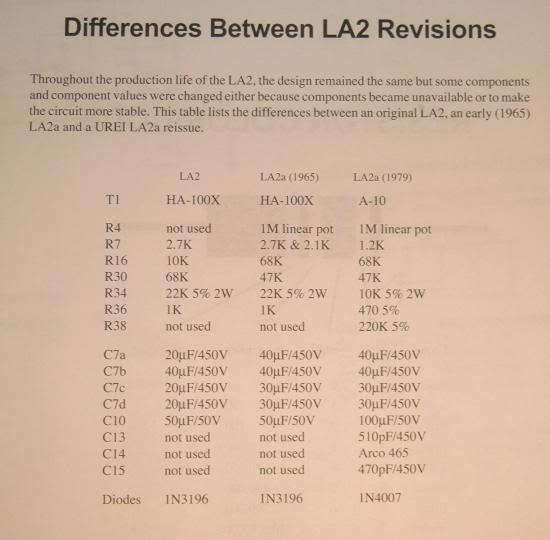airtech
Well-known member
I don't post a lot here, but was wondering if I could get some advice on my LA2A that I'm rebuilding.
I'll send some pictures later. A little history, I built a couple of LA2A's based on the Jahnsen book back
about 5 years ago. One worked, the other didn't. Check and rechecked. Swapped tubes and also t4b's.
I'm using his layout, point to point, with ha100x's and a24's for the transformers.
Here's a link to some pictures of the unit: http://s907.photobucket.com/albums/ac271/airtech101/?albumview=slideshow
My Problem:
After I power it up, no explosions, the meter works fine. I ran some audio into it and the meter responds.
First thing I noticed is that the gain knob on the left, when all the way off, still lets audio through. When
I turn it up about a quarter turn the meter slams to the right. When I turn the right reduction knob, around
a quarter as well, distortion/crackling is audible. So I checked the voltages against Jahnsen's Voltage Chart.
Here's what I got:
12ax7#1 - pin1-144volts, pin3-1.17volts, pin6-150volts, pin8-1.28volts
12bh7 - pin1-124volts, pin3-4.69volts, pin6-276volts, pin8-130volts
12ax7#2 - pin1-111volts, pin3-tohardtogetto, pin6-111volts, pin8-0.93volts
6hg5 - pin2-50volts, pin5-330volts, pin6325volts
The voltage on the 6hg5 is way high on all pins and the other voltage on the other tubes are approx. 25% more
than whats in the book voltage chart. Any ideas on what could be happening? I've checked and rechecked the
wiring and can't see any obvious mistakes. Maybe a bad component somewhere. Thanks for any help here.
Nate
I'll send some pictures later. A little history, I built a couple of LA2A's based on the Jahnsen book back
about 5 years ago. One worked, the other didn't. Check and rechecked. Swapped tubes and also t4b's.
I'm using his layout, point to point, with ha100x's and a24's for the transformers.
Here's a link to some pictures of the unit: http://s907.photobucket.com/albums/ac271/airtech101/?albumview=slideshow
My Problem:
After I power it up, no explosions, the meter works fine. I ran some audio into it and the meter responds.
First thing I noticed is that the gain knob on the left, when all the way off, still lets audio through. When
I turn it up about a quarter turn the meter slams to the right. When I turn the right reduction knob, around
a quarter as well, distortion/crackling is audible. So I checked the voltages against Jahnsen's Voltage Chart.
Here's what I got:
12ax7#1 - pin1-144volts, pin3-1.17volts, pin6-150volts, pin8-1.28volts
12bh7 - pin1-124volts, pin3-4.69volts, pin6-276volts, pin8-130volts
12ax7#2 - pin1-111volts, pin3-tohardtogetto, pin6-111volts, pin8-0.93volts
6hg5 - pin2-50volts, pin5-330volts, pin6325volts
The voltage on the 6hg5 is way high on all pins and the other voltage on the other tubes are approx. 25% more
than whats in the book voltage chart. Any ideas on what could be happening? I've checked and rechecked the
wiring and can't see any obvious mistakes. Maybe a bad component somewhere. Thanks for any help here.
Nate




